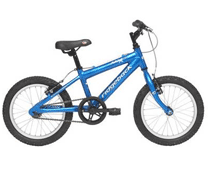CHILDRENS BIKE GUIDE
Riding a bike and the enjoyment it can bring is a vital stepping stone in any child's development. On the practical side, cycling develops the vital skills of coordination, balance and judgement of speed and danger, learning through mistakes what the bike and the body can do. Alongside the physical benefits, having a bike gives a child that first sense of freedom, and as they get older enables them to do things independently from their parents without having to rely on lifts in the car to get to a friends house or the shops. Cycling also opens up the opportunity for family based activities and cycling trips are a fun way to spend quality time together, pottering around the lanes. This can be done on separate bicycles if the youngster's skills are developed or if still too young they can be carried with the parent either in child seats or attached to the bike on a purpose built half bike or trailer. These attach to the adult's bike and gives the child the sensation of speed and pedaling without worrying about steering and other road users.
Buying a bicycle for a child of any age can be a confusing process. The range of bike sizes that manufacturers produce is extensive and it can be difficult to know exactly which size of bike your child needs. All kids grow at different rates, so what is right for one five year old will not necessarily fit another. In this guide we hope to help clear the fog around bike sizing you should be looking at and what you should look for in a bike to suit the nature of the riding and the attitude of the child. Alongside individual cycles we will also explain what types of child seats are available, how they fit and how safe they are. We will also look at the range of children's trailer bikes available and their compatibility and fit.
Sizing
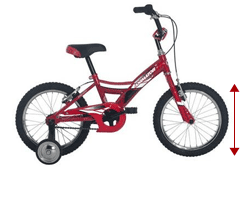
Children's bicycles are manufactured in several different wheel sizes starting at 12" and rising in 2" increments until the child is of a size to fit comfortably onto a small adult bike (26" wheel, 14" frame) All youngsters grow at different rates, so the ages shown that correspond to the different wheel sizes are only meant as a general guide. It is also worth noting (before you start taking out a loan to pay for numerous bikes!) that it is not necessary to buy every size of bicycle as your child grows. With the use of an adjustable seat post, most kids will be able to move a couple of sizes up when they have outgrown their original bikes.
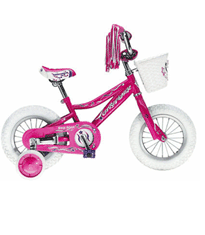
12" Wheel- 2 to 4 yrs
At two years old most children are ready to start experiencing the joy of riding a bicycle but are not quite ready to start using the pedals. To help in the process manufacturers such as Giant and Puky manufacture bikes that are designed to help the infant get used to sitting and controlling a cycle and even using brakes, but without having to coordinate pedaling. Leading from these the range moves onto full 12" wheel models which have everything a bicycle will need in miniature form - ideal for that first riding experience. Learner bikes without pedals are manufactured in child friendly plastics and steel to withstand the punishment they will have to endure and can be used effectively when the youngster is 90cm tall and above. Expect to pay £50 - £60. 12" designs with pedals come with essentials such as stabilizers and are built to last. You can expect to pay £80 - £120.
14" Wheels 3 to 5 yrs
This size of childrens bicycle is not produced by many manufacturers but is a useful size for taller three year olds or if you have extended the use of a 12" wheel bike to get as much use from it. A 14" cycle should give enough use to see the child through to a 20" bike. Expect to pay similar prices to a 12" model - around the £100 mark.
16" Wheel 4 to 6 years
At this size most infants will be looking to remove the stabilizers and experience riding a two wheeled bike without any balancing aids for the first time. The bicycles here will be more than suitable to fulfill this important stage in their development. At this age many kids are far more aware of what their friends at school are riding and so fashion can also start to play a part - a factor not lost on the majority of manufacturers who produce mini BMX bikes, small MTB cycles and pretty designs for girls complete with pannier racks and baskets. Expect to pay between £100 and £150 for a bike that should provide a good couple of years of fun and learning.
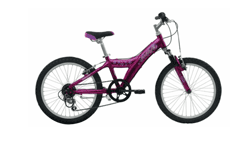
20" Wheel 5 to 8 yrs
With the same size wheel as a BMX, the 20" wheel bicycle for many is the last stepping stone before being ready for a small adult design. This is recognised by the manufacturers who start to add more advanced elements to the bikes such as suspension and better gears which all enable the young rider to increase their skill with some more advanced cycling. Expect to pay between £130 and £230.
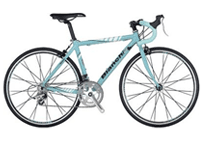
24" Wheel 8 to 11 yrs
Many youngsters move from a 20" wheel to a 26" wheel with a small 14-15"frame, but not all children are ready for an adult bike. If the child is moving from a 16" wheel having outgrown it, then a 24" bike is often a great alternative as the sizing will make it that little bit easier to handle. It will still offer long term use with the seatpost adjustable as the child grows. Expect to pay between £140 and £500, at which point you will be paying for a small racing or MTB cycle that utilises the same lightweight frames and components as adult bikes.,
Here is a quick guide to the heights and ages that manufacturers recommend for their bicycles.
| 12" | 2-3 years | (35 to 43 cm) 14"-17" | (1.00m - 1.25m) 3'6" - 4'2" |
| 14" | 3-5 years | (40 to 50 cm) 16- 20" | (1.10m - 1.3m) 3'8" 4'5" |
| 16" | 4-6 years | (45 to 53 cm) 18"-21" | (1.2m - 1.45m) 4' - 4'8" |
| 20" | 7-8 years | (55 to 63.5 cm) 22"-25" | (1.35m - 1.57m) 4'6" - 5'2"d |
Things To Keep In Mind
The measurements we use at AW Cycles are a good guide, but avoid buying a bicycle with the intention that "a child will grow into it". Especially when they are younger kids will find the bike will be hard to control and hard to ride which may either cause them to fall off more or ruin their confidence, enjoyment and desire to ride in the first place. Most cycles come with a long adjustable seatpost and a long steerer tube that means the stem and handlebars can be raised to match the seat. Look out for both of these as they can really maximise the growing room. When on the bike a child will often have their seat a little lower than we would recommend for an adult bike as pedal efficiency is less of a priority versus safety. An infant should be able to touch a foot down on the ground when they are seated on the saddle so that they can always control themselves at slow speeds.
Frames & Weight
At the lower end of the ranges many children's bikes are built for reliability to make sure that it can withstand the punishment that it will undoubtedly receive. Typically even a 16" wheeled cycle can weigh as much as 15 kilos, which depending on the age of the rider could be half their body weight. This will make cycling that little bit harder so it is often worth considering, especially if your little one is on the small side, looking at buying a lighter framed model. This may cost slightly more but your child will get more out of their cycling. For a 20" and 24" cycle look for a complete weight of around 13kg or less, especially if they are likely to go off road. Difficult terrain will be tackled more easily and a lighter bicycle will be far easier to get up slopes and keep up with friends.
Components
Manufacturers do not just put full size standard components on children's bikes as they are very aware that this will make the riding a lot harder for little legs and hands. Instead the bicycles will come with scaled down components. Some things to look out for include:
- The size of the cranks. As a guide these should be around 10% of the child's height (a 140cm infant will need 140mm cranks)
- The brakes. As a vital safety aspect on any bike, they need to be reachable by smaller hands, which is why shorter adjustable reach brake levers are a must for little children.
When buying and setting up a bicycle make sure that the levers are easily reachable. If not the brakes levers will either need to be replaced or more often than not they will need to be re-positioned.
Gears
Unless the child is racing in youth events on the road or off road, the number of gears is really more of a status symbol amongst their friends - the more they have the better the bike must be! This may be true but most children's bicycles will come with either 7-8 speed, which with a triple chainset is the equivalent of 21 and 24 speed. BMX cycles only use a single speed. More gears can mean more mechanical complications so most pre-teen cycles will not come with a front derailleur and only one chain-ring on the cranks. This is not a problem as the kind of riding that most will do does not require a large spread of gears. However, if this ever becomes a problem and the bike frame is the correct size then it is not a complicated process to change the chainset. If the bicycle is of good quality it will certainly be less expensive then replacing the entire thing.
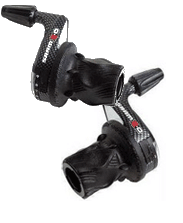
How To Change The Gears
Most children's cycles come with a grip shift. This is a shifter attached to the handlebars at the end of the grip and as the name suggests the child simply places their hand around the grip and twists (like revving a motorbike). The gears are sequenced to change one click at a time.
Most grip shifters will come marked with the gears so that at a quick glance the cyclist can see which gear they are riding in. These shifters require less effort to change for young hands and wrists and are inexpensive to replace if damaged. On older kids bikes look out for quick fire shifters operated with two levers on the bars using the thumb. These will generally only be used at the higher end of the range as they are more expensive to fit. However, they can last longer and work more efficiently.
Other Components To Look Out For
Other things to look out is a bolt-on derailleur protector which is vital to protect the gears in the event of a crash or more often to protect them when the bike is thrown down on the ground with a little care. The suspension on kids bikes is basic but will add to the look of the design and smooth out some of the bumps on a rough path. It is not designed to be complicated so as not to add to the maintenance time. Rear suspension will add weight and potentially require more maintenance - on younger riders' cycles it is best avoided. The wheels on a junior bike are just scaled down versions of those found on adult models. This means that if they are damaged a spoke can be replaced and the hub can be repaired. However, if the rim is damaged the wheel will probably need to be replaced. If in doubt about the cost of repairing a wheel as opposed to buying a replacement, contact one of our expert wheel builders who will be able to give you a quote so you can decide on the best course of action to get the bike back on the road.
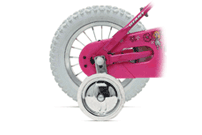
Stabilisers
Stabilisers are standard issue with the 12 ½" wheeled bikes and most of the 16" wheeled models. They can also be bought as an add-on to suit bicycles up to the 20" wheel size. They can always be taken off later, however, they will take lots of knocks and do need to be fitted properly - hence they are best fitted with a new bike, if needed.
Essential Things To Remember!
It's vital to purchase a helmet with a bicycle, not just to protect your child's head whilst riding, but also to help ensure that helmet wearing becomes a life-long habit. Many manufacturers produce a range of specific infant helmets to fit all head sizes from the very small to the young adult. They are very aware that peer group pressure can also be important when a child puts on a helmet, which is why a variety of colours and styles are available so that the young rider will always fit in with what they and their friends consider cool. Other things to think about are elbow and knee protectors if they are getting a little bit more adventurous. If riding a BMX they will be pressuring you for them as body protectors are totally integrated into the BMX and jump bike scene. Gloves and long trousers and tops can be useful as a protective layer from scrapes.
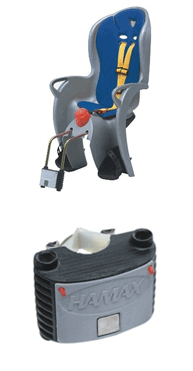
Child Seats
As soon as a baby can sit up unaided for long periods of time (normally around 9 months) they are ready to use a child seat. They can sit in the seat up to the age of four or five if they wish, as most are designed to accept them. However, at this age weight will become an issue and can make cycling hard and unstable. Most manufacturers recommend a weight limit between 18 - 22kg.
Safety
Safety is the biggest concern of most parents when fitting a seat onto their bicycle. Manufacturers are very aware of this and each seat has to conform to strict guidelines before being sold. All safety seats will be molded from plastic that wraps around the child and offers protection if the bike falls on its side, as well as preventing wayward feet from venturing too near the spokes in the wheel. All seats are fitted with a safety harness or waist band and often a grab bar for the infant to hold onto. To stop children slumping when asleep (especially for the younger ones) some manufacturers make recliner seats which offer additional support. A very basic requirement is to fit the child with a suitable helmet that can be found to fit all ages.
Fitting
The seats attach to the cycle in two main ways. The first type attaches to the seat tube of the frame using special brackets.
These are quick and easy to fit and the seat can also be easily detached leaving the bracket in place when not required. These will fit nearly all models except full suspension frames and really small frames of 15". The second type attach to the pannier eyelets manufactured on the frame of the cycle
These are very secure but cannot be used on bicycles that are not designed to accept panniers or mudguards. The other available mechanisms include cross bar (top tube) seats which, as the name suggests, attach to the cross bars with the child almost sitting in your arms. Front child seats attach to your handle bars with brackets but are limited to smaller kids.
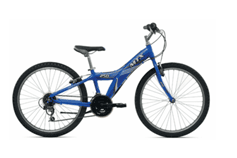
Bike Handling
A youngster can add a lot of weight onto your bike, with even a little one equaling the equivalent weight of loaded panniers. The weight is also high up and to the rear of your bicycle (with a rear seat) which means that your handling can be seriously compromised. Things that might help with this include attaching wide riser bars that can give you more control as they make sure that the gear ratio is wide enough. A wide spread of gears on the rear wheel and a triple chainset will make riding slowly with a heavier bike more manageable. Fitting a wide strong tyre on the back wheel will offer a more comfortable ride for both the cyclist and passenger. Another important aspect to consider is the shape of the frame. Most hybrid bicycles will come with a compact frame and many women's specific bikes still come with a shallow top tube that allows the rider to step through the frame when mounting and dismounting.
It can be a tricky manoeuvre to swing your leg over the seat with a child on the rear. You should either purchase a suitable model of bike or (especially for men) practice mounting and dismounting so that you can master the technique. It is important to get into the habit so that you don't forget and scare your youngster with a foot coming rather too close to his or her head.
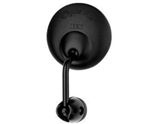
Other Gadgets Which Might Help
A secure bike stand can help when parked up. A twin leg centre stand offers more stability when getting your infant in and out of the seat and can be a big help when actually fitting the seat. A cycling mirror can be a good idea, especially as the decreased handling of the bicycle caused by carrying a youngster can mean that when looking over your shoulder the bike tends to veer into the traffic. By fitting a mirror you can safely check for cars behind without turning your head.
Rear lights can be fitted to a child seat easily as many come with suitable brackets. This is essential as many normal places to attach a light can be inaccessible or obscured having fitted a child carrier. Always wrap the kids up from the elements with lots of layers and waterproof clothes in the winter and sun protection on the summer. This may sound obvious but it is easy to forget how cold it can get on a bicycle if you are not pedaling.
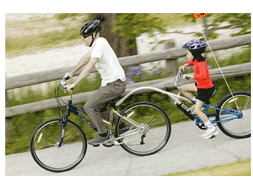
Trailer Bikes
A great way to get out on the road with your child in a safe and controlled environment is to teach them the skills necessary to control a bike with the help of a trailer bicycle. These attach to your standard models and have a rear wheel, handlebars, saddle and cranks attached by a chain to a freewheel. This means that the adult is not simply towing the youngster but they can actually contribute to the speed that the bicycle is moving. Most of the time this will of course mean that they are not pedaling, but they can still gain a lot from the experience, as can the adult.
Types of Trailer.
The main types of trailers found on the market are those that attach to the seatpost using an easy clamp that is both safe and simple to apply.
There is a second type that attaches to a rack on the bicycle, although very few manufacturers use this method. Post hitches provide great value for money and use pivot points that are set back form the bracket and seatpost which is vertical to the ground and allows the trailer to move behind the without effecting the handling dramatically. One thing to look out for is to make sure that your bike does not have a carbon seatpost. They are not designed to cope with high clamping forces and so could easily break. Any aluminium or steel post will be fine! Be aware that the size and age of the child is limited. Many trailers say that they will be able to be used with kids up to the age of 10, but this is only a guide. The more weight on the trailer the harder the bicycle is too handle. If your child is larger or heavier then use common sense and see how this affects the handling. If the cycle feels unmanageable around corners then it is probably time to get the little one onto their own bike and put the trailer away.
The wheels on trailers are normally 20" which is the same measurement as on BMX wheels so replacement tubes and tyres are easy to find when punctures occur. Manufacturers will produce the bikes with single speed gears for simplicity, although some are starting to develop six speed gear systems that teach the child how to shift gears and how to use the ratios while in a safe environment. Most manufacturers will exclude brakes as children are often not aware of the effect that braking can have on the pulling bike. One thing to remember is that trailers are not designed for speed so make sure that no matter how much you and your son/daughter are enjoying the sensation of speed, keep it sensible.
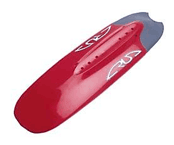
Extras
Most manufacturers will make spare hitches that can be purchased separately. These will enable you to keep a hitch on different bicycles, enabling the trailer to be easily swapped between models. The size of the seatpost can vary so most trailers will come with shims to fit the hitch to the post. These often get lost or extras are needed so different size shims can also be purchased separately. Mudguards are tricky to fit with a trailer on the rear so MTB mudguards such as crud catchers are a great solution to keep the mud from both the rider and the infant.
As with child seats it is essential that the youngster wears a helmet and is dressed appropriately for the weather and the type of riding you plan on doing.



